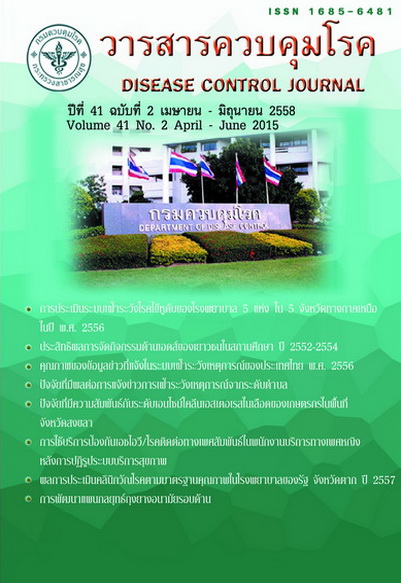Factors associated with event-based surveillance reporting from sub-district level
DOI:
https://doi.org/10.14456/dcj.2015.21Keywords:
event-based surveillance, reporting, data qualityAbstract
In 2013, below half of sub-districts in Thailand had reported abnormal events into the event-based surveillance system. To identify factors associated with events reporting and quality of outbreak detection, a cross-sectional analytic study was conducted during July-December 2014. Three hundred and one districts were selected and classified into 2 groups by the median number of district reports in each province as group of frequent reporting districts (146 ) and group of infrequent reporting districts (155). Statistical analyses 120 were done by Epi info 3.4.3. The results showed that characteristics of both groups were similar except number of sub-districts in the district (p<0.0001). Factors significantly associated with events reporting were receiving the assessment of Disease Control District Qualified Criteria, certification of SRRT standard, coverage of sub-districts in using logbook and web-application for events reporting, number of personnel in charge at district level, having related project and performance indicators, route of outbreak news communi¬cation within district, receiving notification and use of data from the surveillance system. In 2013, there were 320 events showed in questionnaire survey. The Group of frequent reporting districts had more high numbers and more non-public health data sources. The number of events from this survey was matched with the events in the event-based surveillance database and the national outbreak verification database for 25.31% and 10.00%, respectively. Improving system quality needs clear standard and performance indicators, streng thening work mechanism at district level, new reporting channel, increasing new data sources, and studying the quality of event reporting.
Downloads
References
2. สำนักระบาดวิทยา กรมควบคุมโรค. คู่มือวิทยากร (ครู ก) หลักสูตร SRRT เครือข่ายระดับตำบลและการพัฒนาระบบเฝ้าระวังเหตุการณ์ (event- based surveillance) ในระดับตำบล. นนทบุรี: กรมควบคุมโรค; 2553.
3. ลดารัตน์ ผาตินาวิน, บุญโรม มาตรา. ประเมินผลการใช้โปรแกรมคอมพิวเตอร์แจ้งข่าวเหตุการณ์ผิดปกติทางสาธารณสุขโดยเครือข่ายระดับตำบล. วารสารควบคุมโรค 2556;39:82-91.
4. กรมควบคุมโรค กระทรวงสาธารณสุข. คู่มือประเมินอำเภอควบคุมโรคเข้มแข็งแบบยั่งยืน ปี 2556. นนทบุรี:สำนักจัดการความรู้; 2555.หน้า. 1-13.
5. สำนักระบาดวิทยา. สรุปรายงานการเฝ้าระวังโรค ประจำปี 2556. กรุงเทพมหานคร: ชุมนุมสหกรณ์การเกษตรแห่งประเทศไทย; 2557. หน้า. 209-14.
6. สำนักงานคณะกรรมการพัฒนาระบบราชการ (สำนักงาน ก.พ.ร.). คู่มือการจัดทำมาตรฐานและการปรับปรุงการบริการ. กรุงเทพมหานคร: สุขุมวิทมีเดีย มาร์เก็ตติ้ง; 2553. หน้า. 19-20.
7. Dil Y, Strachan D, Caimcross S, Korkor AS, Hill z. Motivations and challenges of community based surveillance volunteers in the northern region of Ghana. J Commun Health I internet I. 2012 Icited 2014 Dec 29|;37:1192-8. Available from: http://springer.libdl.ir/article/ 10.1007/S10900-012-9569-5
8. คณะกรรมการบริหารจัดการระบบข้อมูลสุขภาพ กระทรวงสาธารณสุข. สรุปผลการดำเนินงานการปฏิรูประบบข้อมูลสุขภาพ กระทรวงสาธารณสุข ระยะเร่งด่วน (มิถุนายน - 30 กันยายน 2557) [อินเทอร์เน็ต]. [สืบค้นเมื่อ 29 ธ.ค. 2557] แหล่งข้อมูล: https://www.scribd.com/doc/ 246424741/สิ่งที่ส่งมาด้วย2-สรุปผลการ ดำเนินงาน.pdf
9. ปฏิภาณ เหงบารู. Jakuwah Model: ทีม SRRT ท่ามกลางสถานการณ์ความไม่สงบ. ใน: สำนักจัดการความรู้, บรรณาธิการ. ประชุมวิชาการป้องกันควบคุมโรคแห่งชาติ ประจำปี 2557; 13-15 มีนาคม 2557; โรงแรมอิมพีเรียล ควีนส์ ปาร์ค, กรุงเทพมหานคร. กรุงเทพมหานคร: ชุมนุมสหกรณ์การเกษตรแห่งประเทศไทย; 2557. หน้า. 30-41.
10. ปรารถนา ถาวรวงศ์. การใช้ระบาดวิทยาเพื่อพัฒนาระบบเฝ้าระวังเหตุการณ์ในพื้นที่. ใน: สำนักจัดการความรู้, บรรณาธิการ. ประชุมวิชาการป้องกันควบคุมโรคแห่งชาติ ประจำปี 2557; 13-15 มีนาคม 2557; โรงแรมอิมพีเรียล ควีนส์ ปาร์ค, กรุงเทพมหานคร. กรุงเทพมหานคร: ชุมนุมสหกรณ์การเกษตรแห่งประเทศไทย; 2557. หน้า. 66-9.
Downloads
Published
How to Cite
Issue
Section
License
Articles published in the Disease Control Journal are considered as academic work, research or analysis of the personal opinion of the authors, not the opinion of the Thailand Department of Disease Control or editorial team. The authors must be responsible for their articles.






